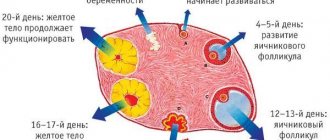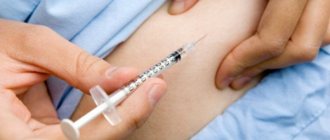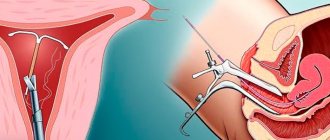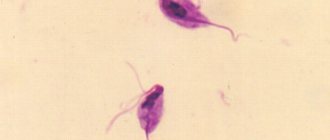A woman’s ovary contains many – up to a million – eggs, but the cells need to mature to create a new organism. Not all eggs mature, but only “selected” ones - then they break away from the ovary, like a grape from a bunch, and exit into the fallopian tube. This release is called ovulation.
If we continue to use metaphors, the process is most similar to the bursting of a small balloon - the follicle in the ovary instantly bursts, and the egg rushes to the uterus. If within 2-5 days she has an encounter with sperm, then there is a high probability of conception.
The ideal option is that ovulation occurs approximately in the middle of the cycle. Women who experience this can plan dangerous and safe days on the calendar. In real life, ovulation does not occur in every cycle, or it occurs 2 times a month. Many factors influence changes in the time of ovulation - from changes in climatic conditions to the general condition of the body.
This is why the calendar method of birth control is unreliable, and if you are planning a pregnancy, you should not rely on an “oral count”.
So on what days does ovulation occur and is it possible to accurately plan pregnancy?
Determination of late ovulation
The release of the egg (oocyte) from the follicle must occur at a strictly defined time. Usually this period is considered the middle of the cycle, that is, with a cycle of 25-26 days, “day X” is expected on the 12-13th day, but in fact the calculation is a little more complicated.
The menstrual cycle is divided into two: the period before ovulation (follicular phase) and after it (luteal phase). In the first period, complex processes occur. First, the functional layer of the endometrium, which has not absorbed the embryo, is rejected within three days, then the wound surface begins to heal, and by the 5th day the formation of a new endometrium begins to replace the rejected one. The synthesis of the “fresh” functional layer continues for 12-14 days (starting from the 5th day of the cycle).
The duration of this period is not strictly fixed, because the uterus needs not only to “grow” new cells, but also to give them the opportunity to grow to 8 mm, and also to provide them with a large number of tubular glands.
The duration is strictly defined only for the second phase of the cycle and is 14±1 days (this is how long the corpus luteum lives in anticipation of pregnancy). That is, to find out the day of oocyte maturation, you need to subtract 13, maximum 14 days from the first day of expected menstrual bleeding. And if this figure is less than 13 days, ovulation is considered late. That is, late ovulation with a 30-day cycle - when it occurred later than the 17th day from the first day of the expected menstruation. When the cycle is longer, for example, 35 days, then the release of an oocyte that occurred after 21-22 days can be called late.
Many women are interested in the question of when the latest ovulation may occur. The answer is difficult to calculate, because it depends on the duration of the cycle. So, if the cycle is within 30-35 days, then the release of the egg less often occurs later than 10-11 days before menstruation. That is, after the 25th day (if from one period to another - no more than 35 days) you should not wait for it. Most likely, this cycle is anovulatory, and if you are under 35 years old and anovulation occurs 1-2 times a year, this is a normal situation that does not require intervention.
If more than 35 days pass between menstruation, then such a cycle itself is already considered a sign of illness that requires examination, and it is very difficult to predict the release of an egg.
A little about the female ovulation calendar
Each ovulation cycle can be divided into several stages. From days 1 to 7 of the cycle, the menstrual (follicular) stage lasts, during which several follicles are born and begin to grow in a woman’s ovaries. After about 7 more days, the main one, the so-called Graafian vesicle, begins to stand out among these follicles. It is in it that the egg matures, which will reach full maturity approximately on the 14-15th day of the cycle - on the days of ovulation, which are the most favorable for conception. Often a woman notices that her stomach is tight after ovulation - usually this happens just 2 weeks after the start of the cycle.
Starting from the 15-16th day of the cycle until the onset of menstruation, the so-called “corpus luteum stage” lasts. The burst follicle, from which the egg is released, shrinks and begins to absorb pigments and fats, which color it yellow; hence the name of this period.
Hormonal support of the menstrual cycle
To understand why a doctor may prescribe a certain hormonal drug to normalize the cycle and eliminate late ovulation, let’s consider what mechanisms control the period from one period to another.
Regulation of the menstrual cycle is carried out by a 5-level system:
- The cerebral cortex and its structures such as the hippocampus, limbic system, and amygdala.
- Hypothalamus. This is the organ that “commands” the entire endocrine system. He does this with the help of two types of hormones. The first are liberins, which stimulate the production of the necessary “subordinate” hormones (for example, folliberin gives the pituitary gland the command to produce follicle-stimulating hormone, and luliberin gives the “order” to synthesize luteinizing hormone). The second are statins, which inhibit the production of hormones by the underlying endocrine glands.
- Pituitary. It is he who, at the command of the hypothalamus, produces FSH hormone, which activates the synthesis of estrogen, and luteinizing hormone (LH), which triggers the production of progesterone.
- Ovaries. Produce progesterone and estrogen. Depending on the balance of these hormones, the production of which is controlled by the hypothalamic-pituitary system, the phase and duration of the menstrual cycle depends.
- Hormonal balance is also affected by organs that are sensitive to changes in the level of sex hormones. These are the mammary glands, adipose tissue, bones, hair follicles, as well as the uterus itself, vagina and fallopian tubes.
In the first phase of the cycle, the pituitary gland produces FSH and LH. The latter causes the synthesis of male hormones in the ovary, and FSH causes the growth of follicles and the maturation of the egg in one or more of them. During this same period, a small amount of progesterone is found in the blood. There must be a strictly defined amount, because both a decrease and an increase will negatively affect the onset of ovulation.
In addition to its effect on the follicles, FSH causes the conversion of androgens into estrogens. When the amount of estrogen reaches its maximum and because of this the amount of LH increases, after 12-24 hours the oocyte should leave the follicle. But if luteinizing hormone or androgens become higher than normal, ovulation does not occur.
After the oocyte is released into “free swimming,” LH decreases and progesterone levels increase, reaching its peak 6-8 days after the oocyte is released (days 20-22 of the 28-day cycle). These days, estrogen also increases, but not as much as in the first phase.
If the egg leaves the follicle late, on day 18 or later, this may be the result of one of the following situations:
- During the period before ovulation, estrogen “dominates” in the blood, to which the body cannot “oppose” anything. This prevents the uterus from preparing for pregnancy. If a woman wants to get pregnant, she is prescribed progesterone during late ovulation, in a course of 5-10 days from the second half of the cycle (usually from 15-16 to 25 days, but optimally - immediately after determining the release of the follicle, even if it happened late).
- The concentration of LH and androgens increases. In this case, contraceptives with an effect that suppresses androgen production help solve the problem.
- There is a deficiency of estrogen, which can be suspected from the fact that follicle growth during late ovulation is very slow. This is corrected by prescribing estradiol drugs in the first half of the cycle (usually from the 5th day). You cannot plan a pregnancy while taking synthetic estrogens.
How to determine the days of ovulation as accurately as possible?
One of the most effective ways to determine the period of release of a mature egg from the follicle is to measure temperature. The basal temperature drops slightly before ovulation, this happens approximately a day before it begins. Directly on the days of ovulation, the temperature rises by 0.3-0.6 °C. If a woman enters data into a temperature chart every day, she can track the dynamics of temperature changes and accurately determine the day on which ovulation is possible. The temperature is measured in the woman's anus every morning immediately after waking up using the same thermometer.
Another reliable way to determine the beginning of ovulation days is to use special tests that are sold at pharmacies.
Reasons for “late” ovulation
Late release of the egg can be triggered by: prolonged stress, climate and time zone changes, abortion or discontinuation of OK. The reason is also a change in hormonal balance in the first year after childbirth if a woman is breastfeeding. Past illnesses, especially infectious ones (flu, etc.), can cause menstrual irregularities such as late ovulation. Also, a shortening of the second period of the cycle will be characteristic of the upcoming menopause. Finally, sometimes such a deviation in the functioning of the reproductive system can be an individual characteristic of a woman.
Often the causes of late ovulation are gynecological diseases, which are characterized by an increase in estrogen in the blood (endometriosis, endometrial hyperplasia, some types of breast cancer), diseases with increased levels of male hormones (polycystic ovary syndrome, pathologies of the adrenal cortex). Late ovulation in a 28-day cycle may be the only sign of low-grade inflammation of the uterus or fallopian tubes, ovarian cysts, as well as genital tract infections caused by chlamydia, trichomonas, and ureaplasma.
A similar symptom (displacement of the release of the egg cannot be called a disease) also occurs with various endocrine pathologies of the pituitary gland, hypothalamus, adrenal glands or ovaries. It also develops with obesity, which is also a disease, because adipose tissue is involved in the metabolism of hormones.
Symptoms
The following signs will tell you that an oocyte is still being released, albeit later than expected:
- Changes in vaginal secretion: it becomes similar in viscosity to chicken protein, streaks of blood may appear in it, and all the mucus may come out brown or yellowish in color. Implantation bleeding occurs in a similar way, occurring only after ovulation, a week later.
- A pulling sensation in the lower abdomen, usually below the navel and on one side.
- Enlargement and extreme sensitivity of the mammary glands: any touch causes discomfort or even pain.
- Irritability, sudden mood swings, increased emotionality.
- Increased sexual desire.
How to recognize that ovulation is possible today?
In different women, symptoms indicating the onset of ovulation may be more or less pronounced. However, there are a number of signs that indicate the onset of ovulation days:
- A sharp increase in sexual desire - thus nature itself increases the likelihood of conception during this favorable period;
- The color of the natural discharge from the woman’s genitals changes somewhat (towards reddish or pinkish) and its consistency - it becomes more liquid and resembles egg white;
- On the days of ovulation, not very pronounced nagging pain in the lower abdomen may periodically occur;
- An increased amount of mucus is secreted in the cervical area.
Late ovulation and conception
Conceiving during late ovulation is quite possible if such a shift in the schedule is not caused by polycystic ovary syndrome, endometriosis or another disease. Some sources indicate that even in the absence of these diseases, just shortening the second phase of the cycle reduces the chance of pregnancy from 90% to 30%.
Therefore, if after ovulation recorded by the temperature chart or test has passed and a delay in menstruation appears, it is likely that conception has occurred. Its probable occurrence will be indicated by such signs as changes in appetite and taste preferences, enlargement and tenderness of the mammary glands, nausea (especially in the morning). A pregnancy test for late ovulation can be performed only after 10-14 days: earlier, the level of human chorionic gonadotropin (hCG) will not be high enough to be detected in the urine. Determining this hormone in the blood will be more informative. But here the hCG numbers during late ovulation will also be lower.
So that the doctor assessing the results of this test does not frighten the woman with suspicions of fetal fading in the early stages (the analysis will indicate the date of the last menstruation, taking into account which the increase in hCG can be interpreted as too small), you need to inform him that ovulation occurred later than necessary .
If a woman experiences late ovulation, then her pregnancy is also at risk, which is associated with a shortening of the luteal phase, during which the body does not have time to properly prepare for bearing a fetus. Therefore, on the 7th day after “day X”, it is recommended to donate blood to determine progesterone in it, and if the test on days 10-14 is positive, you need to consult a doctor who, if necessary, will prescribe progesterone-containing drugs.
How to calculate the gestational age?
In this case, you will have to count from the moment the oocyte is released, taking it as the starting point: 1 week after ovulation - 1 week of gestation.
Do I need treatment?
Only a doctor can tell whether treatment is needed for late ovulation, or whether this is a temporary phenomenon. Perhaps the simplest measures - maintaining a healthy diet, sufficient physical activity, and regular sex life - can change the situation for the better.
In some cases, based on an analysis of the basal temperature chart and hormone tests, hormonal medications can be prescribed, for example, Duphaston, a progesterone drug taken in the second phase (from 15 to 25 days). The effect of this medication does not occur immediately: it takes at least 3 months to judge the result.











